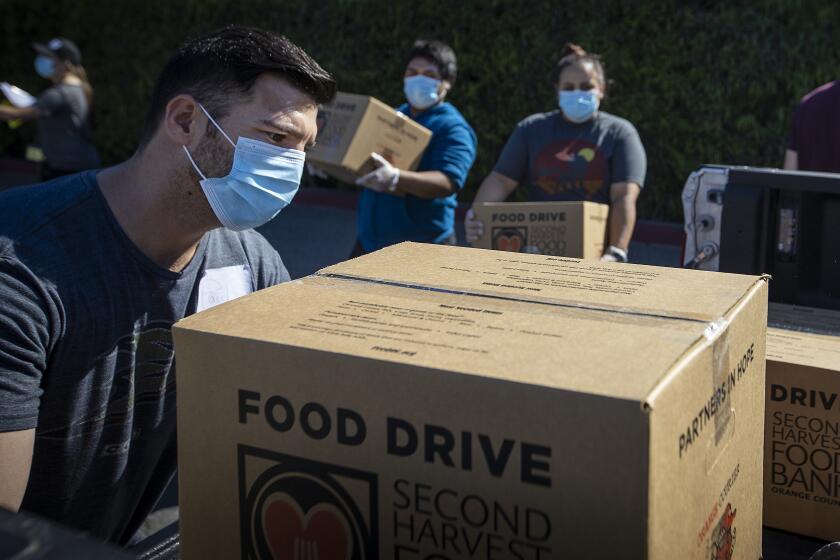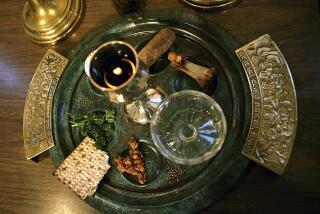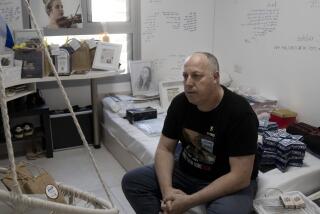Celebrate Passover a new way (Zoom, anyone?) in the time of coronavirus

- Share via
Passover commemorates the Exodus, when Moses led the Jewish people out of slavery in ancient Egypt. Families and friends recount the story at the Seder table, when food symbolizes the steps of their escape.
“Passover is a holiday when we eat the story in order to learn the story,” said Rabbi Susan Goldberg, founder of the spiritual community Nefesh and the rabbi consultant on the TV series “Transparent.”
But how do we celebrate Passover, which begins Wednesday, in the time of the novel coronavirus? Here are safe ways to come together when social distancing keeps us apart.
Join a community Zoom Seder
Google “Zoom Seder” to find an electronic Seder to your liking. University Synagogue will host a Reform version; you can download the Haggada (the Seder text) in advance. The Nefesh Seder will deliver Seder kits and suggest kids activities. “Before the Seder starts, we’ll do a fun ‘Kids Jam,’ with songs, some jumping around, blessings on the matzo,” Goldberg said.
(Full disclosure: Times owner Dr. Patrick Soon-Shiong is an investor in Zoom.)
Streaming church services and virtual Easter egg hunts are among the ways to make the most of our first — and, we hope, last — Easter in self-isolation.
Create your own Zoom/FaceTime Seder
First, decide on the Haggadah everyone will use. Sarah Bunin Benor, professor of contemporary Jewish studies at Hebrew Union College–Jewish Institute of Religion, Los Angeles, created a downloadable Haggada PowerPoint complete with videos, images and songs. “I encourage people to edit the slides to their liking,” she said. For those with a creative urge and the time, Haggadot.com makes it easy to create a personalized Haggadah with family photos and more.
“For the past 35 years, we held a Seder for 50 to 60 people in our home,” said George Rimalower, whose parents were Holocaust survivors. “This year, we’ll have 40 to 50 people on 15 to 20 screens, some joining it from as far away as Buenos Aires.” Rimalower will send a PDF of his Haggada and assign readings in advance.
He plans to open Zoom on his wide-screen TV. “That way, my wife, Cathi, and I will feel like our family and friends are in our house,” he said.
Missing ingredients for the Seder plate?
The Seder plate holds the essential symbolic Passover foods. But what if horseradish root, which represents the bitterness of slavery, is hard to find? “Use a lettuce leaf instead,” said Amelia Saltsman, author of “The Seasonal Jewish Kitchen.” “In ancient times, lettuce was bitter. Even though it’s mild now, many Israelis still use it on the Seder plate.”
What if you can’t find a lamb-shank bone, symbol of the Passover sacrifice? “I’ve kept my shank bone in my freezer in between Seders for at least 40 years, but a chicken leg bone will do,” said Judy Bart Kancigor, author of “Cooking Jewish.” Can’t spare an egg, symbol of spring and the continuing cycle of life? “Use an avocado pit,” she said.
“If you don’t have Seder plate ingredients in the house, a picture will suffice,” Bunin Benor said. “The Seder might not taste or smell the same, but you’ll have the experience of thinking and talking about the symbolism and the Exodus story.”
Missing ingredients for the traditional Passover dinner?
Saltsman usually slow-roasts beef brisket, but she hasn’t been able to find one this year. She is making her cookbook’s simple chicken in the pot recipe instead.
If you decide not to cook, consider picking up or ordering delivery of a Seder. L.A. restaurants such as Huckleberry, Akasha, Art’s Deli and Jar are offering them. Wolfgang Puck’s Spago, which has put on a community Seder for 36 years, is adding a ritual Seder plate with its takeout meal. “We lowered the price to encourage guests to donate to Mazon, which battles hunger,” said co-owner Barbara Lazaroff.
If you have extra food, here’s how you can help local food banks or pantries. If you are struggling to buy food, this guide has information for you.
Keeping kids entertained
The Seder can be long, and young ones can get antsy or sleepy. Before the Seder, parents can help their children create wacky costumes representing the 10 plagues (frogs are a favorite), or devise a fun Moses-versus-Pharaoh “Let my people go!” skit.
Kids love hunting for the afikomen, a piece of matzo the Seder leader hides during the service. Zoom participants can arrange to hide theirs in the same place — under the children’s beds, for example. When all the children find theirs, make sure they all get the same sweet reward.
Make the Seder relevant to today
The ancient Israelites lived through the 10 plagues; today, we’re living through one. The Seder service may be a time to discuss it. Rimalower added coronavirus questions to the four-sons portions of the Haggada.
“This is where you explain the Exodus story so that everyone — even the youngest person there — can understand it,” he said. “I realized that kids are as upset about COVID-19 as grown-ups, so I added four more questions so we could talk about it: The inquisitive child asks, ‘Why are people getting sick?’ The worried child asks, ‘What if the virus keeps spreading and never stops?’ The compassionate child asks, ‘What can I do to keep me and the others healthy and safe?’ The resilient child asks, ‘When it’s over, how can we keep it from happening again?’ ”
David Wolpe, senior rabbi at L.A.’s Sinai Temple, added his wisdom for this terrible time. “The first night of Passover was before the Israelites left Egypt,” he said. “They were frightened and did not know what would happen.
“This year, we share their apprehension of the future and the uncertainty gnaws at us. But there will be a time of deliverance … . To the extent possible, enjoy the evening. Do not lose the moment in anticipation of tomorrow.”
More to Read
Sign up for The Wild
We’ll help you find the best places to hike, bike and run, as well as the perfect silent spots for meditation and yoga.
You may occasionally receive promotional content from the Los Angeles Times.







